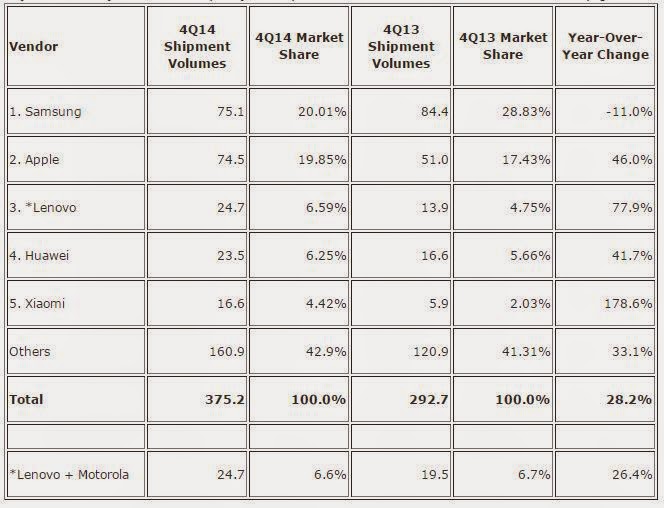In 2014, global smartphone shipments grew considerably thanks to emerging markets such as India and Indonesia. There was a whooping 30 percent increase from 1 billion units sold in 2013 to a record of 1.3 billion units being sold in 2014.
A Strategy Analytics report tells us that the most dominating phone OS around the world was Android. Around 1 billion Android based handsets were shipped worldwide in 2014, rising from 0.8 billion units in 2013. With these numbers, Android became the first ever smartphone OS to ship more than 1 billion units in a single year.
The above chart gives us clarity on how Android shipped over 780 million units in 2013 and comparatively sold a little over 1042 million units in 2014. Android dominated a huge 81 percent share of all smartphones shipped globally in 2014. On the other hand, Apple iOS shipped 192.7 million smartphones worldwide in 2014, capturing 15 percent share. Apple’s Q4 results portrayed an increase thanks to the iPhone 6 and iPhone 6 Plus sales and thanks to the high margins on the iPhones, it ended up being a profitable quarter. Microsoft’s Windows occupied a tiny share with a 3 percent drop in market share was witnessed. Windows is still struggling to make it through in the smartphone market.
What we can understand from these numbers is that Android has had the most significant increase in terms of market share in the past two years. As there are so many Android makers in the market today, consumers are open to a wide range of options. More droids are sold which in turn increase their stake in the market. iOS, it’s main competitor had a higher market-share in 2014 than it did in the previous year. Of course, as their iPhone sales began towards the end of the year, their market share increased in Q4 as compared to Q4 in 2013.
We know that Android dominates the market, but which smartphone vendor has the majority stake in Google’s OS?
The above chart by IDC explains us the market share and units shipped in the fourth quarter. In 2013, IDC talked about the smartphone industry topping the 1 billion unit milestone, but it is clear from the charts that it took another year to achieve that milestone. Now the year-on-year growth in sales of smartphones from 2012-2013 was 40.5% in 2013 whereas in the 2013-2014 year-on-year growth dropped to 27.6% in 2014. This past year volumes surpassed 1.3 billion units and the vendor scenario has witnessed continued shakeups. Growth is forecast to decline to the mid 2015, but the opportunity surely exists since much of the world’s population is either not a wireless subscriber or has yet to move to a smartphone.
According to the chart, Samsung was at the top, but showed a significant decline in the market share along with the quarterly results. Comparing to 2013, there was a 11 percent drop overall in 2014. Again, Apple showed a significant increase in sales in 2014 – 46%.
Lenovo was number three on the list showing a 77.9 percent year-on-year growth. It should be pointed out that Motorola is also a part of Lenovo which does give a certain added advantage to the company. Huawei also proved to make profits and will still continue to grow in 2015. The winner over here clearly was Xiaomi. The company had a 178.6 percent growth in 2014 compared to the previous year but also had a whooping increase in shipments from 5.9 million in 2013 to 16.6 million in 2014.















